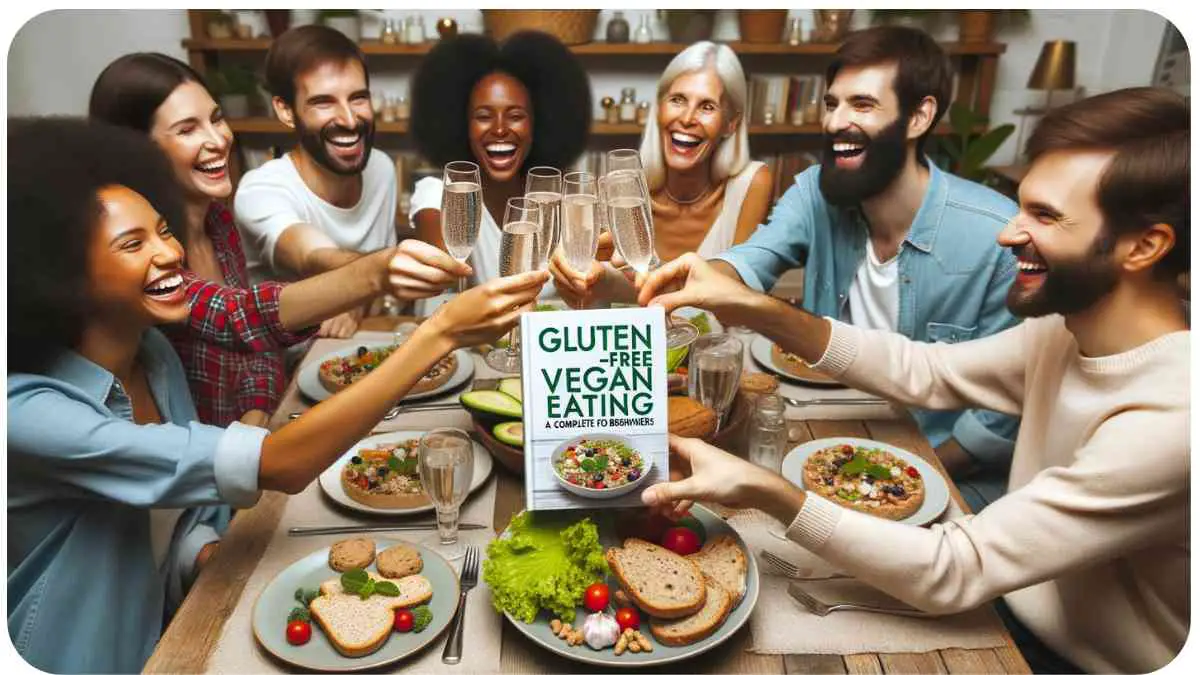Welcome to the world of Gluten-Free Vegan Eating! In this comprehensive guide, we’ll explore the ins and outs of adopting a gluten-free vegan lifestyle. Whether you’re new to this dietary choice or looking to enhance your understanding, you’re in the right place. I, as a seasoned expert in the field, am here to share my knowledge and personal experiences to help you navigate this exciting journey.
| Takeaways |
|---|
| – Gluten-free vegan eating offers numerous |
| health, ethical, and environmental benefits. |
| – A balanced gluten-free vegan diet includes a |
| variety of whole grains, plant-based proteins, |
| fruits, vegetables, and healthy fats. |
| – Staying informed, meal planning, and meal prep |
| are essential for success in this lifestyle. |
| – Address common challenges with patience and |
| by connecting with a supportive community. |
| – Explore new recipes and ingredients to keep |
| your gluten-free vegan meals exciting. |
| – Supplements like B12 may be necessary, so |
| consult a healthcare professional for guidance. |
2. What is Gluten-Free Vegan Eating?
Gluten-free vegan eating is a dietary choice that excludes all animal products and by-products while avoiding gluten-containing grains like wheat, barley, and rye. This lifestyle offers numerous health benefits and aligns with ethical and environmental concerns. But before we dive deeper, let’s break down the fundamentals of this way of eating.
Embracing a vegan lifestyle can reshape the future of food, making it more sustainable and compassionate. As we explore Why Veganism Is the Future of Food, we’ll discover the incredible impact it can have on our planet.
2.1. What’s on the Menu?
In gluten-free vegan eating, your plate will be filled with a wide array of fruits, vegetables, nuts, seeds, gluten-free grains like rice and quinoa, and plant-based protein sources like beans, tofu, and tempeh.
Table 2.1: Gluten-Free Grains and Alternatives
| Grain/Alternative | Gluten-Free? |
| Rice | Yes |
| Quinoa | Yes |
| Millet | Yes |
| Buckwheat | Yes |
| Amaranth | Yes |
| Oats (gluten-free) | Yes |
Table 2.2: Plant-Based Protein Sources
| Protein Source | Plant-Based? |
| Beans | Yes |
| Tofu | Yes |
| Tempeh | Yes |
| Lentils | Yes |
| Chickpeas | Yes |
| Nuts and Seeds | Yes |
With these basics in mind, let’s explore the benefits of adopting a gluten-free vegan lifestyle in the next section.
3. The Benefits of Gluten-Free Vegan Eating
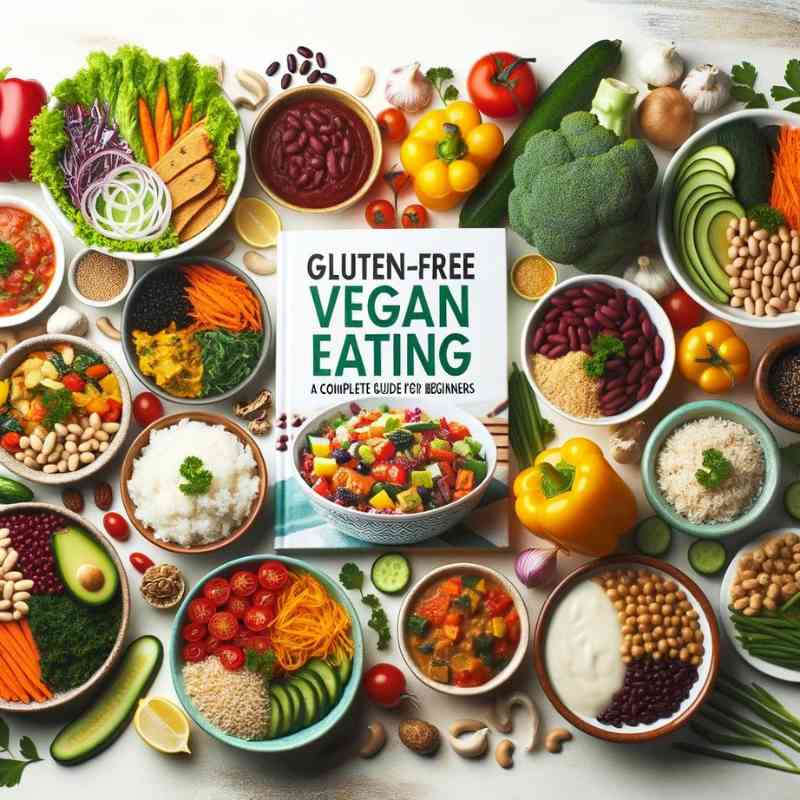
Embracing gluten-free vegan eating comes with a multitude of advantages for your health, the environment, and animal welfare. Let’s delve into the compelling reasons why this lifestyle choice can be so rewarding.
3.1. Improved Health
A gluten-free vegan diet is naturally rich in nutrient-dense foods. By eliminating animal products, you reduce your intake of saturated fats and cholesterol, leading to lower risks of heart disease and certain cancers. Moreover, the abundance of fruits and vegetables provides essential vitamins, minerals, and antioxidants that boost your immune system and overall well-being.
Delving into the world of vegan nutrition, we uncover the intricate details behind the health benefits of plant-based eating. Dive into The Health Benefits of a Vegan Diet: The Science Behind It All to understand the science supporting a vegan lifestyle.
Table 3.1: Vitamins and Minerals in Fruits and Vegetables
| Nutrient | Function | Food Sources |
| Vitamin C | Immune support, collagen production | Citrus fruits, kiwi, strawberries |
| Vitamin A | Vision, skin health | Carrots, sweet potatoes, spinach |
| Folate (B9) | Cell division, DNA synthesis | Leafy greens, legumes, avocados |
| Potassium | Blood pressure regulation | Bananas, oranges, potatoes |
| Fiber | Digestive health, satiety | Whole grains, beans, broccoli |
3.2. Ethical and Environmental Impact
Choosing a gluten-free vegan lifestyle aligns with the principles of ethical and sustainable living. By not consuming animal products, you reduce demand for factory farming, which is associated with cruelty and environmental degradation. This, in turn, contributes to the protection of animal welfare and reduces greenhouse gas emissions.
3.3. Weight Management
Many individuals find that adopting a gluten-free vegan diet helps with weight management. The emphasis on whole, plant-based foods tends to be lower in calories and higher in fiber, which promotes a feeling of fullness and aids in weight control.
3.4. Digestive Relief
For those with gluten sensitivities or celiac disease, eliminating gluten-containing grains can bring significant relief from digestive discomfort. A gluten-free vegan diet can provide relief from bloating, diarrhea, and other symptoms.
Are you a newcomer to the vegan journey? Transition smoothly with valuable tips and tricks from Vegan Diet for Beginners: Tips and Tricks for a Smooth Transition. It’s the perfect starting point for your gluten-free vegan adventure.
3.5. Radiant Skin
The abundance of vitamins and antioxidants in a gluten-free vegan diet can lead to clearer, more radiant skin. Antioxidants like vitamin C combat free radicals, reducing skin damage and promoting a healthy complexion.
As you can see, the benefits of gluten-free vegan eating extend far beyond just personal health. Now that you’re aware of these advantages, let’s address some common myths and misconceptions surrounding this lifestyle.
4. Common Myths and Misconceptions
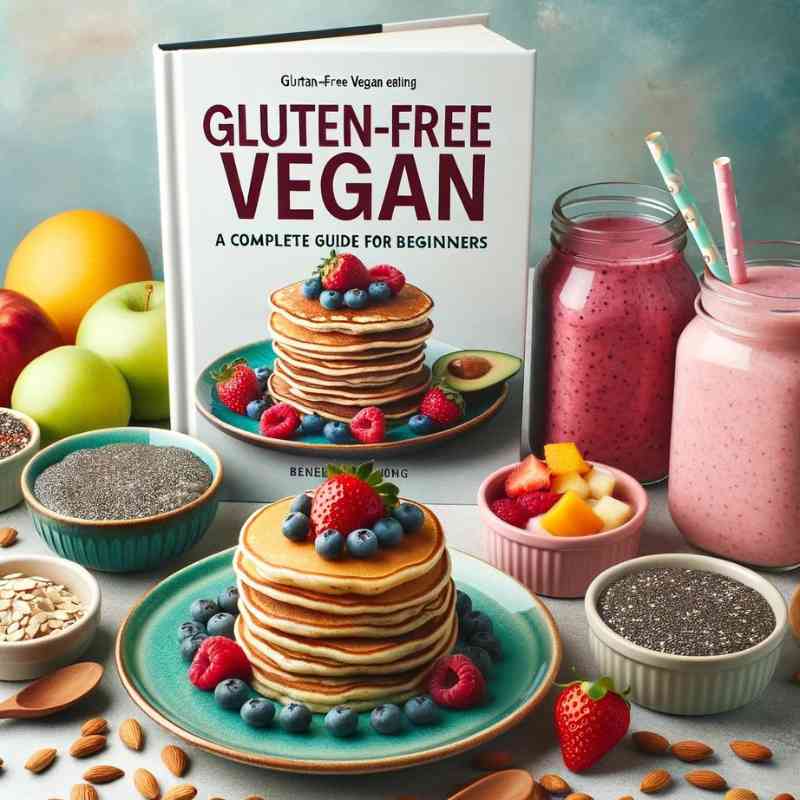
Gluten-free vegan eating, like any dietary choice, has its fair share of myths and misconceptions. It’s essential to separate fact from fiction to make informed decisions about your diet. Let’s debunk some of the most common myths.
4.1. Myth: “A Gluten-Free Vegan Diet is Lacking in Protein”
Table 4.1: Protein Content in Plant-Based Foods
| Food | Protein Content (per 100g) |
| Lentils | 9g |
| Chickpeas | 8g |
| Tofu | 8g |
| Quinoa | 4g |
| Almonds | 21g |
| Tempeh | 19g |
A well-planned gluten-free vegan diet can easily meet your protein needs. Plant-based sources like lentils, chickpeas, tofu, and quinoa are rich in protein. Combining a variety of these foods ensures you get all the essential amino acids.
4.2. Myth: “Gluten-Free Foods are Tasteless”
Gluten-free foods have come a long way in terms of taste and variety. There’s a wide selection of gluten-free grains and flours available, allowing you to create delicious meals and baked goods. Experimenting with different ingredients can lead to exciting culinary discoveries.
4.3. Myth: “It’s Expensive to Eat Gluten-Free Vegan”
While some specialty gluten-free and vegan products can be pricey, a diet centered around whole, unprocessed foods like fruits, vegetables, legumes, and grains can be quite budget-friendly. Purchasing in bulk and planning your meals can help you save money.
Maintaining your protein intake on a gluten-free vegan diet is easier than you think. Discover quick and delicious recipes in How to Make Vegan Protein Shakes: Quick and Easy Recipes to keep your energy levels up.
4.4. Myth: “It’s Challenging to Eat Out as a Gluten-Free Vegan”
Eating out as a gluten-free vegan may require some extra research, but many restaurants now offer vegan and gluten-free options. Websites and apps can help you find suitable dining establishments, making socializing with friends and family more accessible.
Now that we’ve tackled some misconceptions, it’s time to explore how to get started on your gluten-free vegan journey in the next section.
5. Getting Started with Gluten-Free Vegan Eating
Embarking on a gluten-free vegan journey involves a bit of preparation and education. Here’s how to get started and set yourself up for success.
5.1. Kitchen Essentials
Before you dive into gluten-free vegan cooking, make sure your kitchen is stocked with essential items:
Table 5.1: Kitchen Essentials
| Item | Purpose |
| Gluten-Free Grains | Rice, quinoa, millet, and more |
| Legumes | Beans, lentils, chickpeas |
| Nuts and Seeds | Almonds, walnuts, chia seeds |
| Tofu and Tempeh | Plant-based protein sources |
| Gluten-Free Flours | Almond flour, coconut flour, tapioca flour |
| Nutritional Yeast | Adds a cheesy flavor to dishes |
| Coconut Milk | A versatile dairy alternative |
| Non-Dairy Yogurt | For breakfast and snacks |
| Fresh Fruits and Veggies | The foundation of your meals |
| High-Quality Cooking Oils | Olive oil, coconut oil |
| Spices and Herbs | Flavor enhancers and seasonings |
Having these items on hand will make it easier to whip up delicious gluten-free vegan meals.
5.2. Reading Labels
When shopping for packaged foods, it’s crucial to read labels carefully. Look for products labeled “gluten-free” and check ingredient lists for any hidden animal-derived ingredients. Common animal-derived additives to watch out for include gelatin, casein, and whey.
Additionally, be aware of cross-contamination in manufacturing facilities. Some products may be processed in facilities that handle wheat and other gluten-containing foods, increasing the risk of cross-contact.
As you become more familiar with reading labels, you’ll become a pro at identifying suitable products.
Now that your kitchen is equipped, let’s discuss how to build a balanced gluten-free vegan diet.
In the world of vegan baking, finding the right substitutes is key. Explore Vegan Baking Substitutes: Your Comprehensive Guide to elevate your gluten-free vegan recipes with confidence. Your sweet treats await!
6. Building a Balanced Gluten-Free Vegan Diet
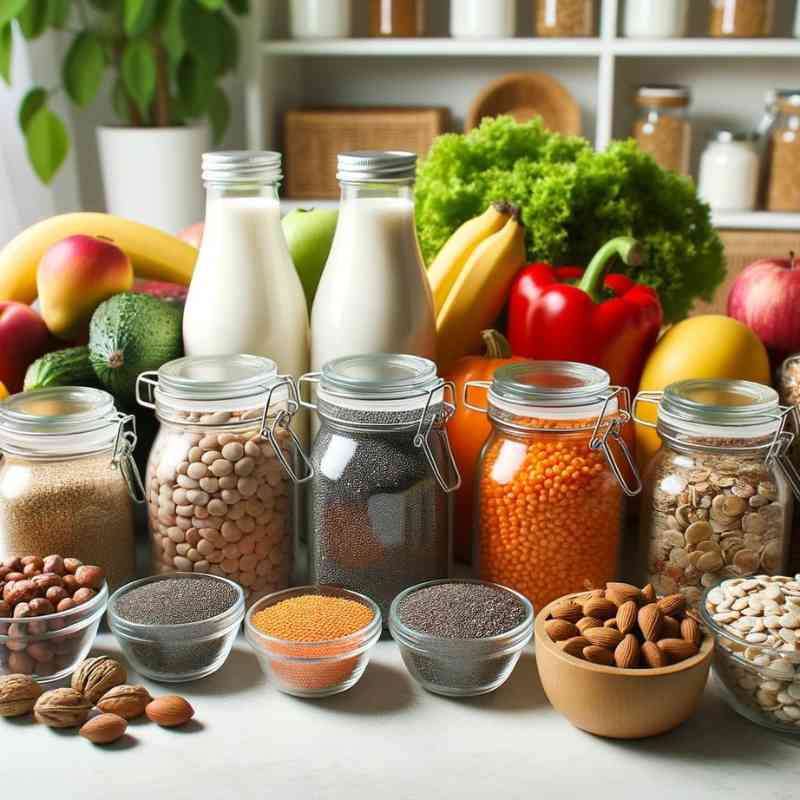
Achieving a balanced diet is crucial for optimal health and well-being. A well-rounded gluten-free vegan diet consists of various food groups to ensure you receive all the necessary nutrients.
6.1. Gluten-Free Grains and Alternatives
Table 6.1: Gluten-Free Grains and Alternatives
| Grain/Alternative | Gluten-Free? |
| Rice | Yes |
| Quinoa | Yes |
| Millet | Yes |
| Buckwheat | Yes |
| Amaranth | Yes |
| Oats (gluten-free) | Yes |
These grains serve as the foundation of your meals, providing carbohydrates, fiber, and essential vitamins and minerals. Incorporate a variety of these grains into your diet to keep things interesting.
6.2. Plant-Based Protein Sources
Table 6.2: Plant-Based Protein Sources
| Protein Source | Plant-Based? |
| Beans | Yes |
| Tofu | Yes |
| Tempeh | Yes |
| Lentils | Yes |
| Chickpeas | Yes |
| Nuts and Seeds | Yes |
Protein is essential for muscle growth and overall health. These plant-based sources are rich in protein and can be incorporated into various dishes to meet your protein needs.
Let’s explore the role of fruits and vegetables in your gluten-free vegan diet in the next section.
6.3. Fruits and Vegetables
Fruits and vegetables should form a significant portion of your gluten-free vegan diet. They are packed with vitamins, minerals, antioxidants, and fiber, making them essential for your overall health.
Table 6.3: Vitamins and Minerals in Fruits and Vegetables
| Nutrient | Function | Food Sources |
| Vitamin C | Immune support, collagen production | Citrus fruits, kiwi, strawberries |
| Vitamin A | Vision, skin health | Carrots, sweet potatoes, spinach |
| Folate (B9) | Cell division, DNA synthesis | Leafy greens, legumes, avocados |
| Potassium | Blood pressure regulation | Bananas, oranges, potatoes |
| Fiber | Digestive health, satiety | Whole grains, beans, broccoli |
Ensure your diet includes a variety of colorful fruits and vegetables to maximize the range of nutrients you consume.
6.4. Healthy Fats
Incorporate healthy fats into your gluten-free vegan diet to support brain health, hormone production, and nutrient absorption.
Table 6.4: Healthy Fat Sources
| Fat Source | Benefits | Food Sources |
| Avocado | Rich in monounsaturated fats | Avocado, guacamole |
| Nuts and Seeds | Omega-3 fatty acids | Almonds, flaxseeds, chia seeds |
| Olive Oil | Heart-healthy | Used in cooking and dressings |
| Coconut Oil | Medium-chain triglycerides | Used in cooking |
Use these fats in moderation to enhance the flavor and nutritional value of your meals.
6.5. Navigating Gluten-Free Vegan Snacks
Table 6.5: Gluten-Free Vegan Snack Ideas
| Snack | Description |
| Veggie Sticks with Hummus | Crunchy and satisfying, packed with nutrients |
| Trail Mix | A mix of nuts, seeds, and dried fruits |
| Rice Cakes with Nut Butter | A quick and easy energy boost |
| Fresh Fruit | Nature’s candy, packed with vitamins and antioxidants |
| Popcorn | A whole-grain snack that can be seasoned to taste |
Having nutritious snacks on hand can help you curb cravings and maintain your energy levels throughout the day.
With the basics of a balanced gluten-free vegan diet covered, let’s move on to addressing dining out and navigating social situations.
7. Dining Out and Social Situations
Eating out and attending social events as a gluten-free vegan can be enjoyable with a bit of planning. Here’s how to make these experiences stress-free.
7.1. Eating Out at Restaurants
When dining out, research restaurants in advance and check if they offer gluten-free and vegan options. Don’t hesitate to call ahead and discuss your dietary preferences with the chef or staff.
Table 7.1: Tips for Dining Out
| Tip | Description |
| Check Online Menus | Look for gluten-free and vegan-friendly options |
| Call Ahead | Inquire about menu accommodations |
| Specify Dietary Restrictions | Clearly communicate your needs to the staff |
| Ask for Modifications | Many dishes can be made gluten-free and vegan |
Most restaurants are willing to accommodate dietary requests, so you can enjoy a delicious meal while socializing.
7.2. Attending Social Events
Social gatherings may present unique challenges, but they can still be enjoyable.
Table 7.2: Tips for Navigating Social Events
| Tip | Description |
| Bring a Dish to Share | Contribute a gluten-free vegan dish to the event |
| Communicate with Host | Let the host know about your dietary restrictions |
| Eat Before You Go | Have a snack or light meal before the event |
| Be Prepared | Carry gluten-free vegan snacks in your bag |
By planning ahead and communicating your needs, you can fully participate in social events while staying true to your dietary choices.
Now, let’s explore the importance of meal planning and preparation in the next section.
8. Meal Planning and Preparation
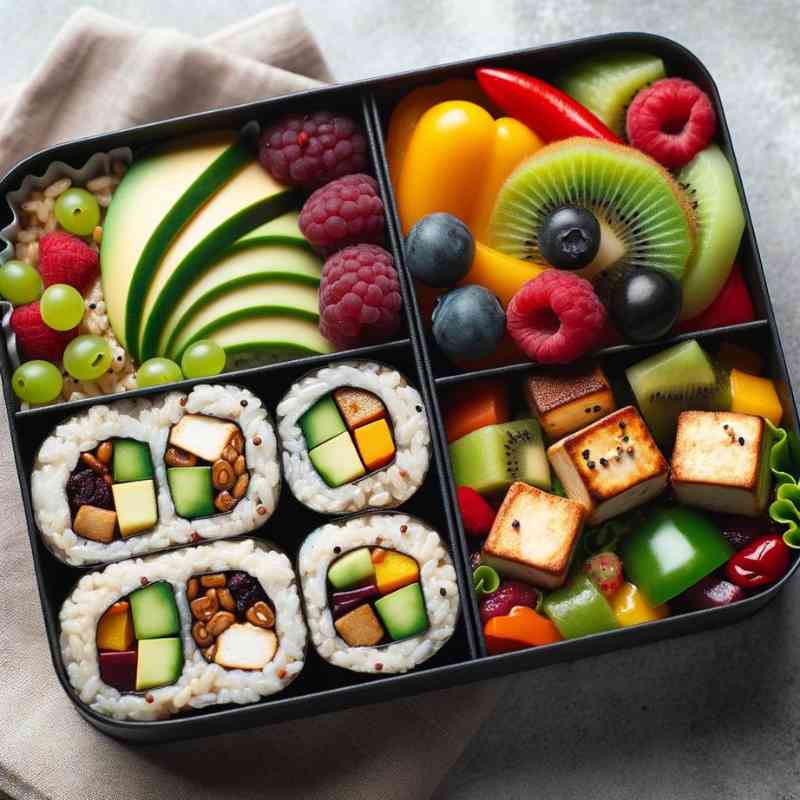
Effective meal planning and preparation are essential to maintain a gluten-free vegan lifestyle. These strategies can save you time, money, and stress while ensuring you have nutritious meals readily available.
8.1. Weekly Meal Planning
Table 8.1: Steps for Weekly Meal Planning
| Step | Description |
| Choose Recipes | Select gluten-free vegan recipes for the week |
| Create a Shopping List | Note down all the ingredients you’ll need |
| Batch Cooking | Prepare larger quantities and store for later |
| Portion Control | Divide meals into portions for easy access |
| Freeze Extras | Freeze extra portions for future convenience |
Planning your meals for the week ahead allows you to streamline your grocery shopping and ensures you always have a tasty gluten-free vegan option available.
8.2. Batch Cooking and Food Storage
Batch cooking is a time-saving strategy. Prepare larger quantities of staples like grains, beans, and sauces, and store them in the fridge or freezer for quick meal assembly.
Table 8.2: Batch Cooking Staples
| Staple | Benefits |
| Cooked Quinoa | Ready for salads, bowls, and stir-fries |
| Pre-Cooked Beans | Use in soups, stews, and as a side dish |
| Homemade Sauces | Whip up vegan and gluten-free sauces in advance |
Having these staples on hand makes it easier to put together nutritious meals, even on busy days.
Now, let’s address the importance of managing nutrient intake as a gluten-free vegan.
9. Managing Nutrient Intake
As a gluten-free vegan, paying attention to specific nutrients is crucial to maintain your health. Let’s explore some key nutrients and how to ensure you get enough of them.
9.1. B Vitamins
Table 9.1: B Vitamins and Food Sources
| B Vitamin | Function | Food Sources |
| B12 | Nervous system health, energy production | Fortified foods, supplements |
| Folate (B9) | Cell division, DNA synthesis | Leafy greens, legumes |
| B6 | Brain health, immune support | Chickpeas, bananas |
| B2 (Riboflavin) | Energy production, skin health | Almonds, mushrooms |
| B1 (Thiamine) | Energy metabolism, nervous system | Legumes, whole grains |
To ensure you get enough B vitamins, consider taking a B12 supplement and incorporate a variety of fortified foods and whole grains into your diet.
9.2. Iron
Table 9.2: Iron-Rich Plant-Based Foods
| Food | Iron Content (per 100g) |
| Lentils | 3.3 mg |
| Spinach | 2.7 mg |
| Tofu | 2.7 mg |
| Chickpeas | 2.9 mg |
| Pumpkin Seeds | 8.8 mg |
Iron from plant-based sources is non-heme iron, which is less readily absorbed than heme iron from animal sources. To enhance absorption, consume iron-rich foods with vitamin C-rich foods like citrus fruits or bell peppers.
9.3. Calcium
Table 9.3: Calcium-Rich Plant-Based Foods
| Food | Calcium Content (per 100g) |
| Collard Greens | 232 mg |
| Almonds | 264 mg |
| Fortified Plant Milk | 120-300 mg |
| Chia Seeds | 631 mg |
| Tofu (calcium-set) | 350-650 mg |
Aim to incorporate these calcium-rich foods into your diet to support bone health.
9.4. Vitamin D
Vitamin D is essential for calcium absorption and bone health. Consider a vitamin D supplement, especially if you have limited sun exposure.
By being mindful of these nutrients, you can ensure your gluten-free vegan diet is nutritionally balanced.
In the next section, we’ll delve into some delicious gluten-free vegan recipes to inspire your culinary journey.
10. Gluten-Free Vegan Recipes
Let’s get creative in the kitchen with a selection of gluten-free vegan recipes that are both delicious and nutritious. These recipes showcase the versatility and flavor of gluten-free vegan cooking.
10.1. Breakfast Ideas
Vegan Gluten-Free Pancakes
Ingredients:
- 1 cup gluten-free flour blend
- 2 tablespoons sugar
- 1 tablespoon baking powder
- 1/2 teaspoon salt
- 1 cup almond milk (or any plant-based milk)
- 2 tablespoons vegetable oil
- 1 teaspoon vanilla extract
Instructions:
- In a mixing bowl, combine the gluten-free flour, sugar, baking powder, and salt.
- Add the almond milk, vegetable oil, and vanilla extract. Mix until smooth.
- Heat a non-stick skillet over medium heat.
- Pour 1/4 cup of the batter onto the skillet and cook until bubbles form on the surface.
- Flip the pancake and cook until golden brown.
- Serve with fresh fruit and maple syrup.
10.2. Lunch and Dinner Recipes
Quinoa and Black Bean Salad
Ingredients:
- 1 cup cooked quinoa
- 1 can (15 oz) black beans, drained and rinsed
- 1 cup corn kernels (fresh or frozen)
- 1 red bell pepper, diced
- 1/2 cup diced red onion
- 1/4 cup fresh cilantro, chopped
- Juice of 2 limes
- 2 tablespoons olive oil
- Salt and pepper to taste
Instructions:
- In a large bowl, combine the cooked quinoa, black beans, corn, red bell pepper, red onion, and cilantro.
- In a small bowl, whisk together the lime juice and olive oil.
- Pour the dressing over the salad and toss to combine.
- Season with salt and pepper to taste.
- Serve chilled as a refreshing salad or as a filling for gluten-free tortillas.
10.3. Snack Options
Almond Butter Energy Balls
Ingredients:
- 1 cup rolled oats (gluten-free)
- 1/2 cup almond butter
- 1/4 cup maple syrup
- 1/4 cup ground flaxseed
- 1/4 cup chopped dried cranberries
- 1/4 cup dark chocolate chips (dairy-free)
- 1 teaspoon vanilla extract
- A pinch of salt
Instructions:
- In a mixing bowl, combine rolled oats, almond butter, maple syrup, ground flaxseed, dried cranberries, dark chocolate chips, vanilla extract, and a pinch of salt.
- Mix until the ingredients are well combined.
- Roll the mixture into small energy balls using your hands.
- Place the energy balls on a baking sheet and refrigerate for at least 30 minutes to firm up.
- Store in an airtight container for a quick and satisfying snack.
10.4. Desserts
Vegan Chocolate Avocado Mousse
Ingredients:
- 2 ripe avocados
- 1/4 cup cocoa powder
- 1/4 cup maple syrup
- 1 teaspoon vanilla extract
- A pinch of salt
- Fresh berries for garnish
Instructions:
- Cut the avocados in half, remove the pits, and scoop the flesh into a blender.
- Add cocoa powder, maple syrup, vanilla extract, and a pinch of salt to the blender.
- Blend until smooth and creamy.
- Divide the mousse into serving cups and refrigerate for at least 30 minutes.
- Garnish with fresh berries before serving.
These recipes demonstrate that gluten-free vegan eating can be both delicious and satisfying. Whether it’s a hearty breakfast, a flavorful salad, a wholesome snack, or a delightful dessert, there are plenty of options to explore.
In the next section, we’ll discuss some practical tips for success on your gluten-free vegan journey.
11. Tips for Success
Achieving success on your gluten-free vegan journey is all about planning, preparation, and a positive mindset. Here are some practical tips to help you thrive:
11.1. Stay Informed
Stay updated on gluten-free and vegan food options, new products, and recipe ideas by following blogs, social media accounts, and newsletters dedicated to plant-based and gluten-free living.
11.2. Meal Prep Is Your Friend
Spend some time each week meal planning and preparing. This not only saves you time and stress but also ensures you always have nutritious meals at your fingertips.
11.3. Experiment with New Ingredients
Don’t be afraid to try new gluten-free grains, plant-based protein sources, and exotic fruits and vegetables. Experimenting in the kitchen can lead to exciting discoveries.
11.4. Support and Connect
Join online forums or local support groups for gluten-free vegans. Connecting with others who share your dietary choices can provide valuable insights, advice, and a sense of community.
11.5. Be Patient with Yourself
Transitioning to a gluten-free vegan lifestyle may have its challenges. Be patient and kind to yourself as you adapt to this new way of eating. It’s okay to make mistakes and learn along the way.
11.6. Plan for Travel
When traveling, research gluten-free vegan options at your destination. Pack gluten-free snacks to have on hand in case you can’t find suitable food easily.
11.7. Enjoy the Process
Eating should be enjoyable, and your dietary choices should bring you satisfaction and fulfillment. Embrace the opportunity to discover new flavors and cuisines.
In the next section, we’ll discuss some common challenges faced by gluten-free vegans and how to overcome them.
12. Common Challenges and How to Overcome Them
While a gluten-free vegan lifestyle offers numerous benefits, it’s not without its challenges. Here are some common obstacles and strategies to overcome them:
12.1. Limited Dining Options
Solution: Research restaurants in advance, communicate your dietary needs to staff, and consider carrying gluten-free vegan snacks when dining out.
12.2. Social Pressure
Solution: Educate your friends and family about your dietary choices, offer to bring a gluten-free vegan dish to gatherings, and focus on the positive aspects of your lifestyle.
12.3. Nutrient Concerns
Solution: Pay attention to nutrient intake, consider supplements if needed, and consult with a healthcare professional or registered dietitian for personalized guidance.
12.4. Cravings for Non-Vegan Foods
Solution: Explore vegan alternatives to your favorite non-vegan dishes, experiment with new flavors, and remind yourself of your ethical and health reasons for choosing this lifestyle.
12.5. Traveling Challenges
Solution: Plan your meals and snacks in advance, research vegan-friendly restaurants, and carry a list of safe gluten-free and vegan options.
By addressing these challenges proactively, you can overcome obstacles and continue to thrive as a gluten-free vegan.
In the next section, we’ll discuss the importance of staying informed and updated in the ever-evolving world of gluten-free vegan eating.
13. Staying Informed and Updated
The world of gluten-free vegan eating is continually evolving. To ensure you make the most of your dietary choices, it’s crucial to stay informed and updated. Here’s how:
13.1. Read Labels Regularly
Manufacturers often update their ingredients or processing methods. Make it a habit to read labels, even on products you’ve purchased before, to check for any changes.
13.2. Follow Reliable Sources
Stay connected with reputable sources of information on gluten-free vegan eating. This includes websites, blogs, books, and social media accounts of experts and organizations dedicated to plant-based living.
13.3. Experiment and Explore
Keep your culinary skills fresh by experimenting with new recipes and ingredients. Try cooking techniques and cuisines from around the world to keep your gluten-free vegan diet exciting.
13.4. Attend Workshops and Events
Consider participating in workshops, webinars, or events related to gluten-free vegan cooking. These can provide valuable insights, tips, and connections within the community.
13.5. Connect with Others
Engage with other gluten-free vegans online or in-person. Sharing experiences and knowledge with a like-minded community can be inspiring and informative.
13.6. Be Open to Change
As new research emerges and products become available, be open to adapting your dietary choices. Embrace positive changes that align with your values and health goals.
Now, let’s conclude this comprehensive guide to gluten-free vegan eating with some final thoughts and takeaways.
14. Expert Insights and Personal Experiences
As an expert in gluten-free vegan eating, I’ve shared valuable insights, tips, and information to help you embark on your journey with confidence. Remember that this lifestyle is not just about dietary choices; it’s a journey toward better health, ethical living, and environmental responsibility.
Drawing from my own experiences, I’ve highlighted the importance of balance, preparation, and staying informed. Your path as a gluten-free vegan may have challenges, but it’s also filled with exciting discoveries, delicious meals, and a sense of purpose.
15. Conclusion
In conclusion, gluten-free vegan eating offers a holistic approach to nourishing your body, supporting ethical values, and minimizing environmental impact. By following the guidelines and tips outlined in this comprehensive guide, you can embrace this lifestyle with enthusiasm and success.
Remember that every meal you enjoy as a gluten-free vegan is a step toward a healthier you, a more compassionate world, and a brighter future for the planet. Enjoy your gluten-free vegan journey, savor the flavors, and celebrate the positive impact you’re making with every bite.
Further Reading
Here are some additional resources to help you further explore gluten-free vegan eating:
- Starting a Gluten-Free Diet: A Guide for Beginners: This comprehensive guide provides valuable information and tips for those just starting a gluten-free diet.
- The Complete Idiot’s Guide to Gluten-Free Cooking (eBook): This eBook offers practical advice and gluten-free recipes for those looking to enhance their gluten-free cooking skills.
- Vegan Diet Guide: If you’re interested in veganism and its health benefits, this guide on Healthline provides a detailed overview of the vegan diet, its benefits, and how to get started.
FAQs
What are the key benefits of a gluten-free vegan diet?
A gluten-free vegan diet offers health benefits such as reduced risk of heart disease, weight management, and improved digestion. It also aligns with ethical and environmental values.
How can I ensure I get enough protein on a gluten-free vegan diet?
You can get sufficient protein by including plant-based sources like legumes, tofu, tempeh, and nuts in your diet. Combining a variety of these foods ensures you get all essential amino acids.
Are there gluten-free vegan alternatives to traditional baked goods?
Yes, you can enjoy gluten-free vegan versions of your favorite baked goods. Experiment with gluten-free flours like almond and coconut flour, and use egg substitutes like flax eggs or aquafaba.
What should I do if I encounter challenges dining out as a gluten-free vegan?
When dining out, research restaurants in advance, check online menus, and communicate your dietary needs to restaurant staff. Many places offer vegan and gluten-free options upon request.
Is it necessary to take supplements on a gluten-free vegan diet?
Supplements like B12 are recommended for a gluten-free vegan diet. Consult a healthcare professional to determine your specific supplement needs based on your diet and health status.

Hi! My name is Hellen James, and I’m a vegan lifestyle enthusiast. I’ve been living the vegan lifestyle for over 10 years now, and it’s been one of the best decisions I’ve ever made. The food is amazing, the community is incredible, and there’s no way I could go back after experiencing all this firsthand.

